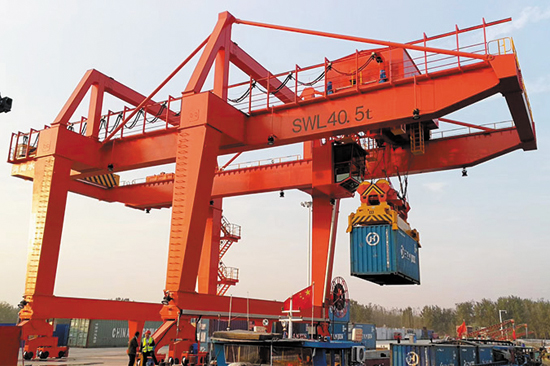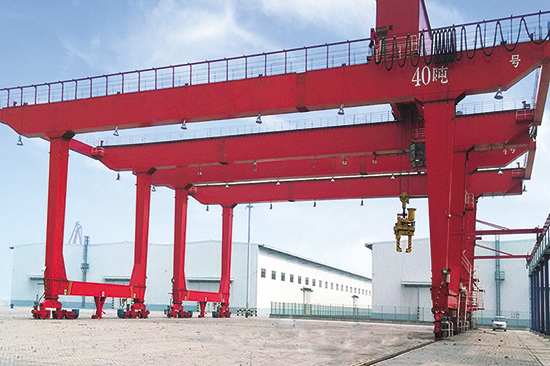Rail-mounted gantry (RMG) cranes have become indispensable in modern container terminals and intermodal yards for efficient and precise handling of heavy loads. As businesses consider investing in an RMG crane, one of the crucial factors that come into play is the price. This article explores the various factors that influence the price of rail-mounted gantry cranes, highlighting key considerations for businesses making this significant investment.
Understanding Rail-Mounted Gantry Cranes
Rail mounted gantry cranes, also known as RMG gantry cranes or container yard cranes, are specialized lifting machines used for the horizontal movement, stacking, and loading/unloading of containers in ports, rail yards, and intermodal facilities. They are typically mounted on rails, allowing them to travel along a predefined path for efficient container handling operations. RMG cranes are renowned for their high lifting capacities, precise positioning, and ability to handle multiple containers simultaneously.

Factors Influencing Rail-Mounted Gantry Crane Price
Lifting Capacity: The lifting capacity of an RMG crane is a significant factor influencing its price. RMG cranes come in various capacities, ranging from 30 tons to over 100 tons. As the lifting capacity increases, the crane’s structural components, motors, and control systems must be engineered to handle the heavier loads, leading to higher manufacturing and installation costs.
Span and Height: The span, or width, and height of an RMG crane directly impact its price. The span determines the distance the crane can cover along the rail tracks, while the height determines the maximum stacking height of containers. RMG cranes with larger spans and greater stacking heights require stronger structural components and additional features, contributing to higher costs.
Rail Configuration: The rail configuration of an RMG crane refers to the number of rails on which the crane operates. RMG cranes can be configured with single or double rails. Single-rail configurations are more cost-effective but have limited stacking height, while double-rail configurations allow for higher stacking capacity but come at a higher price due to the need for additional rails and supporting structures.
Automation and Control Systems: The level of automation and sophistication in the crane’s control systems significantly influences its price. Advanced automation features, such as computerized control systems, remote operation capabilities, and integration with terminal management systems, enhance operational efficiency but come at an additional cost.
Customization and Additional Features: Customization requirements and additional features tailored to specific operational needs can impact the price of an RMG crane. This includes specialized lifting attachments, spreaders, anti-sway systems, intelligent safety systems, and environmental considerations. Each customization and additional feature adds to the overall cost of the crane.

Investment Considerations
Total Cost of Ownership: While the initial purchase price of an RMG crane is a significant consideration, businesses should also evaluate the total cost of ownership over the crane’s lifecycle. This includes ongoing maintenance, spare parts, energy consumption, labor costs, and potential downtime for repairs or upgrades. Choosing a reliable crane manufacturer with a reputation for quality and after-sales support is crucial for minimizing long-term operational costs.
Productivity and Efficiency: The productivity and efficiency gains achieved through the use of an RMG crane can have a substantial impact on overall operational costs and revenue generation. Investing in a crane with higher lifting capacity, advanced control systems, and automation features can lead to faster container handling, reduced labor requirements, and improved operational efficiency.
Safety and Compliance: Safety is of paramount importance in any material handling operation. Businesses should ensure that the RMG crane meets or exceeds all relevant safety standards and regulations. Investing in a crane with advanced safety features, such as collision avoidance systems, anti-sway technology, and operator training programs, can mitigate risks, enhance worker safety, and potentially reduce insurance costs.
Future Expansion and Scalability: When considering the price of an RMG crane, businesses should also evaluate their future growth plans and the scalability of the crane. Opting for a modular design or a manufacturer that offers options for expansion or retrofitting can provide flexibility for future capacity increases or operational changes without significant additional expenses.
The rail mounted gantry crane price is influenced by various factors, including lifting capacity, span and height, rail configuration, automation and control systems, and customization requirements. Understanding these factors and their impact on the crane’s price is crucial for businesses planning to invest in an RMG crane. However, it is equally important to consider the total cost of ownership, productivity gains, safety aspects, and future scalability to make an informed decision and maximize the return on investment. By carefully evaluating these factors, businesses can select an RMG crane that aligns with their operational needs and budgetary constraints while enhancing their container handling capabilities.